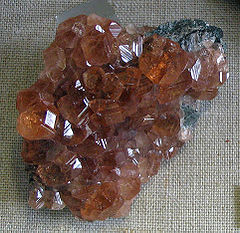- Hessonite
-
Hessonite 
Striated crystals of hessoniteGeneral Category variety of the grossular species Chemical formula Ca3Al2Si3O12 Identification Crystal system cubic[1] Cleavage none, sometimes indistinct parting[1] Fracture conchoidal to uneven[1] Mohs scale hardness 7 Specific gravity 3.64 to 3.69 Polish luster vitreous[1] Optical properties Single refractive, often anomalous double refractive [1] Birefringence none[1] Pleochroism none[1] Hessonite or Cinnamon Stone is a variety of grossular, a calcium aluminium mineral of the garnet group with the general formula Ca3Al2Si3O12. The name is from the Greek hēssōn, inferior, in allusion to its lower hardness and density than most other garnet species varieties.
It has a characteristic red color, inclining to orange, much like that of gem zircon. Indeed it was shown many years ago, by Sir A. H. Church, that many gems, especially engraved gemstones, commonly regarded as zircon, were really hessonite. The difference is readily detected by the specific gravity, that of hessonite being 3.64 to 3.69, whilst that of zircon is about 4.6. Hessonite has a similar hardness to that of quartz, about 7 on the mohs scale, whilst the hardness of most garnet species can reach 7.5.
Hessonite comes chiefly from [[Sri Lanka]and India where it is found generally in placer deposits, though its occurrence in its native matrix is not unknown. It is also found in Brazil and California.
Hessonite is also called Gomedhaka in Tamil and Sinhalese.
References
- Mineral galleries
 This article incorporates text from a publication now in the public domain: Chisholm, Hugh, ed (1911). Encyclopædia Britannica (11th ed.). Cambridge University Press.
This article incorporates text from a publication now in the public domain: Chisholm, Hugh, ed (1911). Encyclopædia Britannica (11th ed.). Cambridge University Press.
http://en.mimi.hu/jewelry/cinnamon_stone.html

This article about a specific silicate mineral is a stub. You can help Wikipedia by expanding it.
